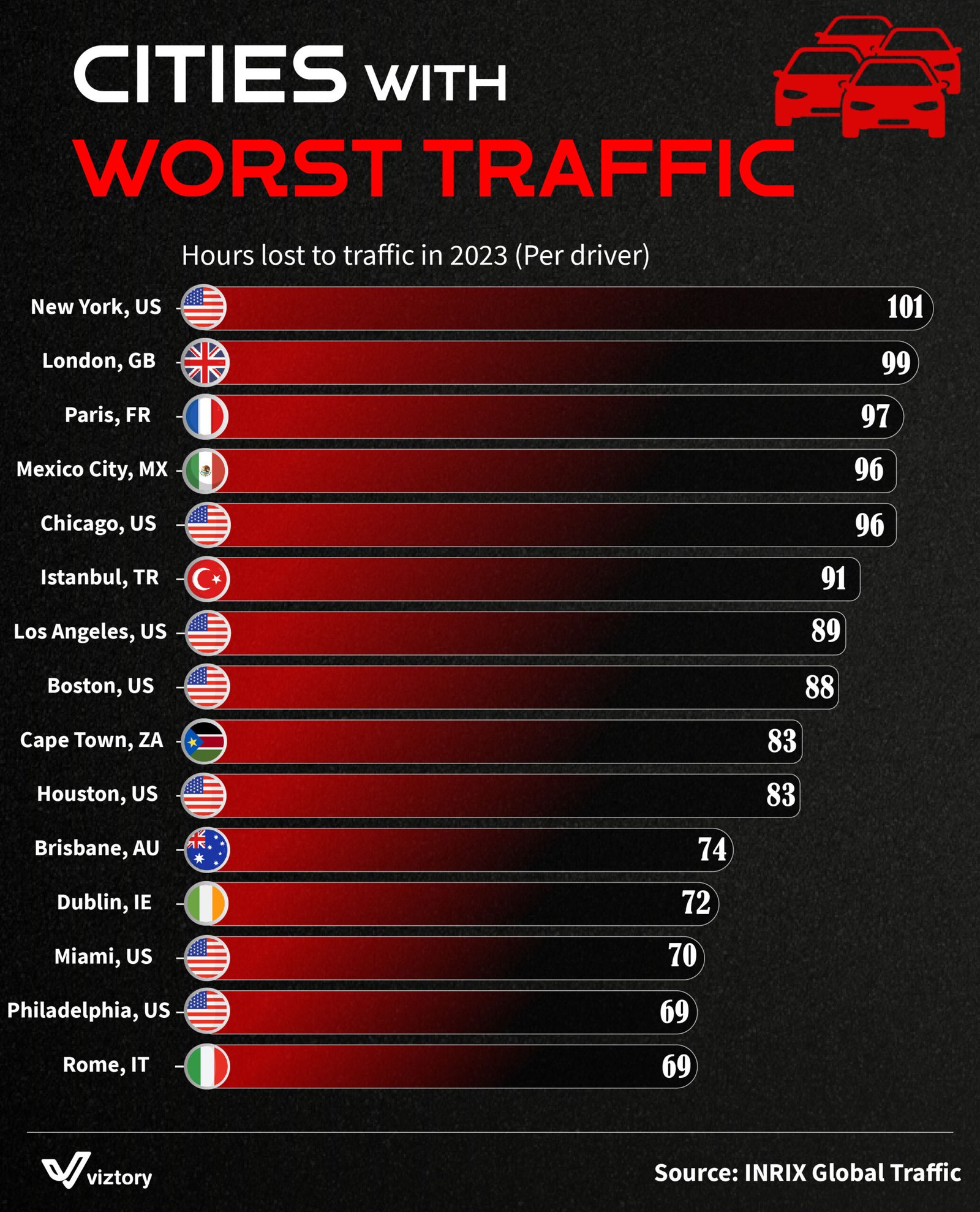Cities with the Worst Traffic
-
Oct, Fri, 2024
Cities with the Worst Traffic: The Health and Environmental Toll of Traffic Congestion
The provided visualization ranks cities by the hours drivers lost to traffic in 2023, with New York, London, and Paris leading the list. Urban centers around the world are facing increasingly severe traffic congestion, and this issue is not just an inconvenience but also a growing threat to public health and the environment. The time lost to traffic translates into more than just frustration; it has direct consequences for air pollution, respiratory diseases, mental health, and overall healthcare systems.
The Hidden Health Costs of Traffic Congestion
As cities become more congested, the link between traffic and public health grows stronger. Traffic congestion is a significant contributor to air pollution, particularly through the emission of pollutants such as nitrogen dioxide (NO2) and particulate matter (PM2.5). These pollutants, primarily from vehicle exhaust, have severe impacts on respiratory and cardiovascular health. In cities like New York, London, and Paris, which top the list for worst traffic, the high levels of air pollution are associated with increased cases of asthma, lung disease, and heart disease.
According to the World Health Organization (WHO), air pollution is responsible for millions of premature deaths annually, and traffic is a key contributor in densely populated urban areas. In London, for example, studies have linked prolonged exposure to high traffic emissions with a higher incidence of respiratory diseases in children and the elderly, placing additional pressure on healthcare systems.
Air Pollution and Chronic Diseases
The rise in chronic diseases due to air pollution is a critical healthcare concern. Exposure to pollutants like PM2.5 not only affects the respiratory system but also has long-term impacts on chronic conditions like diabetes, hypertension, and even cancer. For instance, Mexico City, ranked fourth in terms of hours lost to traffic, is notorious for its high levels of smog, which significantly increases the risk of respiratory illnesses and cardiovascular complications among its residents.
Healthcare systems in these cities are often overwhelmed with patients suffering from pollution-induced illnesses, leading to higher healthcare costs. In cities like Istanbul and Chicago, where traffic congestion leads to over 90 and 96 hours lost per driver respectively, the associated health costs are immense, further burdening already stretched healthcare systems.
Mental Health and Stress
The stress and anxiety caused by traffic congestion also have significant implications for mental health. Prolonged time spent in traffic not only leads to physical health issues but also mental health problems such as anxiety, stress, and even depression. Studies have shown that individuals who spend long hours in traffic report higher levels of stress, which can exacerbate other health conditions such as hypertension and sleep disorders.
In cities like Los Angeles and Boston, where drivers lose 89 and 88 hours respectively to traffic, the impact on mental health is substantial. Mental health challenges lead to a decline in quality of life and require increased healthcare interventions, contributing to the overall healthcare burden.
Traffic-Related Pollution and Vulnerable Populations
Vulnerable populations, including children, the elderly, and individuals with pre-existing health conditions, are particularly susceptible to the effects of traffic-related pollution. For instance, in Cape Town and Houston, where drivers lose 83 hours to traffic annually, the healthcare system sees a disproportionate number of cases involving these vulnerable groups suffering from pollution-induced diseases.
Children, whose lungs are still developing, are at a higher risk of asthma and other respiratory conditions when exposed to traffic pollution. Similarly, the elderly, who often have weaker immune systems, are more vulnerable to the harmful effects of pollutants, leading to a greater demand for healthcare services.
The Environmental Impact and the Ripple Effect on Healthcare
Beyond the direct health consequences, traffic congestion exacerbates climate change through increased carbon emissions. As vehicles idle in traffic, they burn fuel inefficiently, releasing more carbon dioxide into the atmosphere. Cities like Brisbane and Dublin, where drivers lose 74 and 72 hours respectively to traffic, contribute significantly to global greenhouse gas emissions.
Climate change, driven in part by urban traffic, has its own set of health implications. Rising temperatures and extreme weather events, both linked to climate change, further strain healthcare systems. Heatwaves, for example, lead to heat-related illnesses, while changes in weather patterns can affect the spread of infectious diseases. The connection between traffic, pollution, climate change, and healthcare is increasingly evident.
Addressing the Crisis: A Call for Sustainable Urban Planning
Solving the problem of traffic congestion requires bold urban planning initiatives that prioritize public transportation, cycling, and walking over reliance on cars. Cities like Rome and Miami, where drivers lose 69 and 70 hours annually, could benefit significantly from investments in greener infrastructure. Reducing traffic not only lowers air pollution and improves public health but also alleviates the mental strain on residents.
Policies aimed at reducing the number of vehicles on the road, such as congestion pricing, investment in electric vehicles, and promotion of public transport, are essential. As healthcare costs related to pollution continue to rise, cities must invest in long-term solutions to traffic congestion that benefit both the environment and public health.
Conclusion
The traffic congestion data for 2023 paints a stark picture of urban living, but the true cost of these lost hours goes far beyond mere inconvenience. The health consequences of traffic-related air pollution, from chronic diseases to mental health challenges, place an enormous strain on healthcare systems worldwide. As cities grow and traffic worsens, the need for sustainable urban planning becomes ever more urgent. Reducing traffic congestion not only improves the quality of life for residents but also addresses the broader issues of air pollution, healthcare burden, and climate change.

